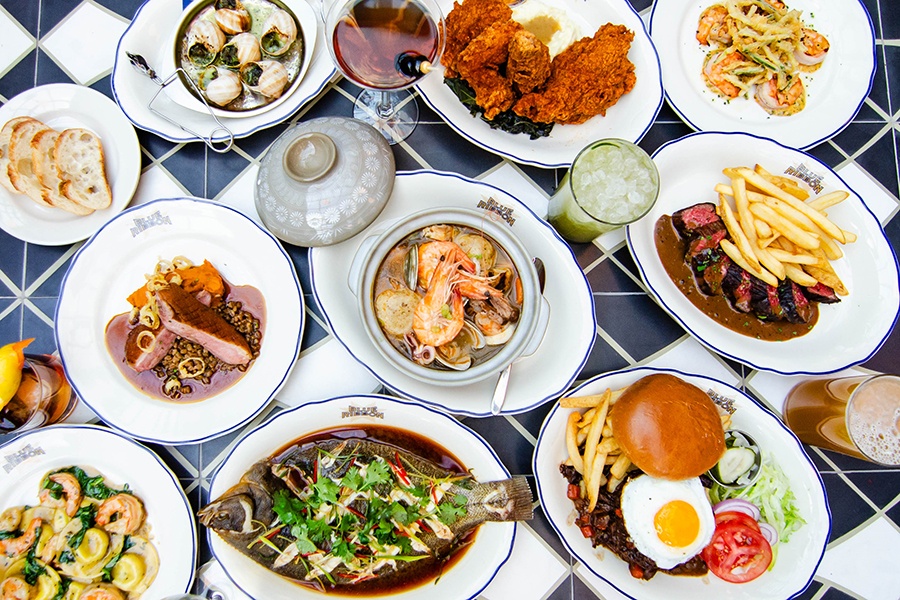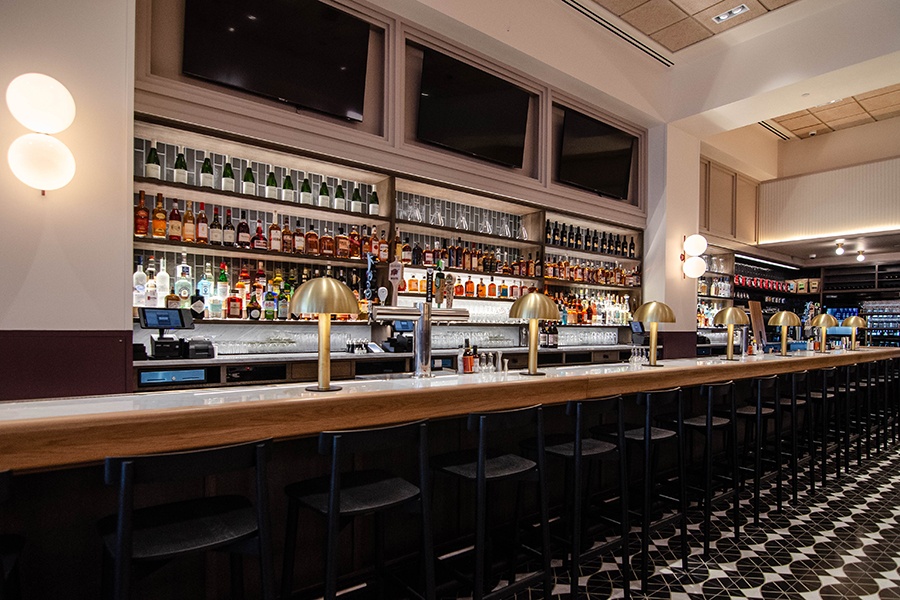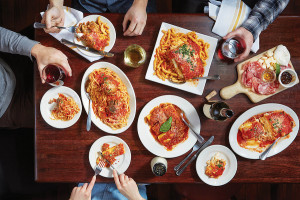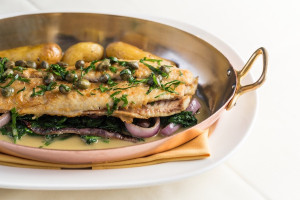Blue Ribbon Brasserie, a New York City Mainstay, Lands in Boston
With late-night hours and a huge menu—from seafood platters to escargots to a loaded matzoh ball soup—there’s something for everyone in the former Eastern Standard space.
When brothers Bruce and Eric Bromberg were about to open Blue Ribbon Brasserie in New York City’s SoHo neighborhood in 1992, they were so busy building the place, Eric’s wife had to remind them they’d forgotten to write the menu and opening was just days away. It was that last-minute brainstorming that led to a selection of dishes packed with childhood inspiration, French culinary training, and everything in between—a menu that remains quite the same today, in New York and now Boston. (There are numerous other concepts from Blue Ribbon Restaurants these days, too, featuring everything from sushi to fried chicken and spanning seven cities.) Boston gets its first taste of the welcoming New York City mainstay on December 5, when Blue Ribbon Brasserie debuts in Kenmore Square alongside siblings Pescador and Blue Ribbon Sushi.
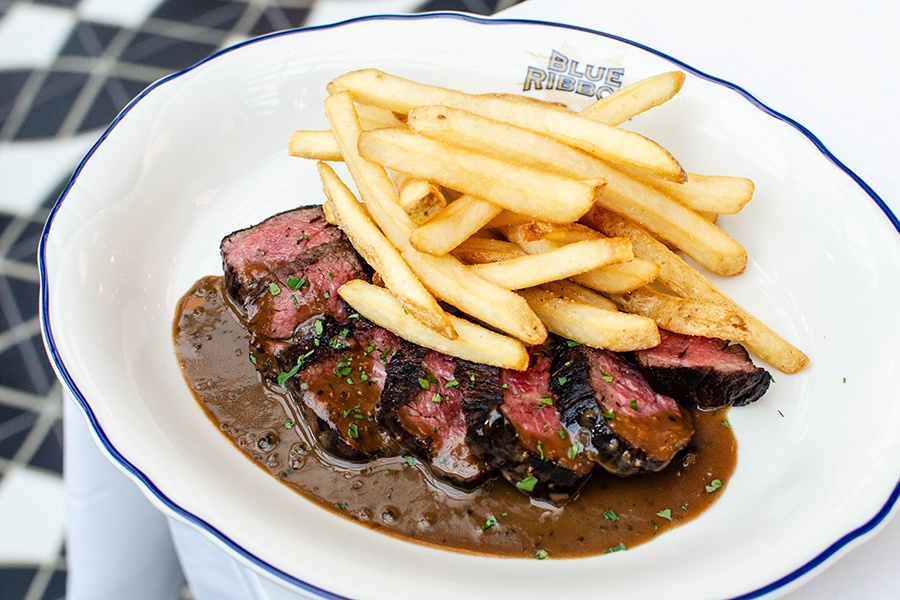
Blue Ribbon Brasserie’s steak frites: nine-ounce bavette with pepper sauce. / Photo by Rachel Leah Blumenthal
“It’s a restaurant for every occasion and every day,” says younger brother Bruce. “It’s a place where you can celebrate your 25th wedding anniversary or the birth of your child, and you can also come after shooting hoops in the park in your sweats and sneakers. You can have a burger and a beer, or you can have oysters and caviar.”
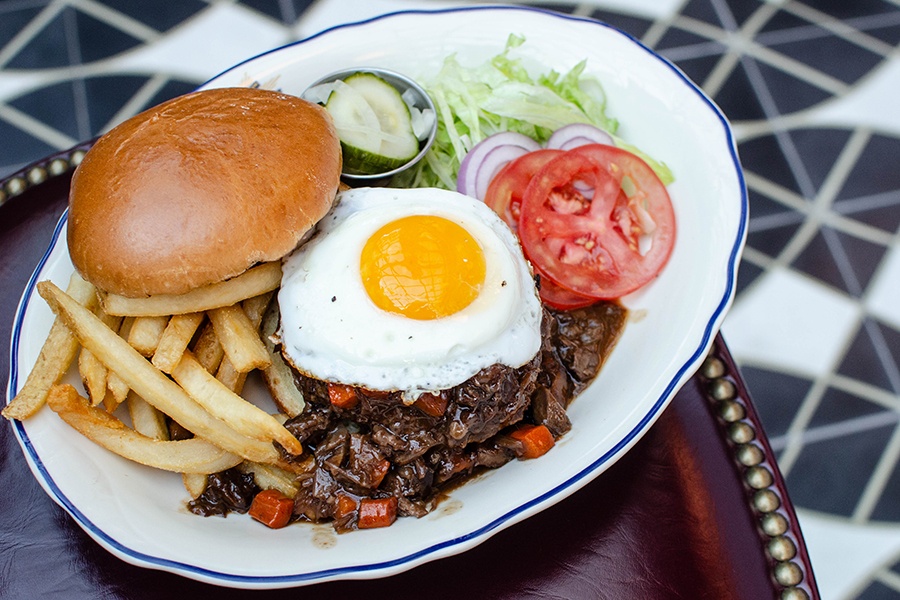
Blue Ribbon Brasserie’s “oxburger”: an eight-ounce chuck-brisket blend with a fried egg and oxtail marmalade, served on a toasted challah bun. / Photo by Rachel Leah Blumenthal
From day one, the menu—which is quite large!—was meant to have something that works for everyone, says Eric. The approach is rooted in a time when the brothers and Eric’s wife were all living together and working in a restaurant. There’d be one night a week they could all go out to dinner together, and the key was to find a place that would make everyone happy. Who wants to waste their one weekly night out on a spot that doesn’t please the whole group?
And so the menu runs the gamut from pierogies to paella to pupu platters. It’s an eclectic assortment, but everything is steeped in the brothers’ upbringing and culinary training. Eric’s favorite dish on the menu, for example, is the shrimp Provencal, a take on a dish that the brothers learned while summering in Provence as kids. “We were in a restaurant in a little town and could see the fire coming up through a crack in the kitchen door,” he says. “One day we asked if we could learn how to cook something, and the chef graciously brought us in and showed us the whole thing. He lit it on fire with Pernod and brandy, and we thought that was pretty much the coolest thing ever.”
“Pretty much why we became chefs,” adds Bruce.
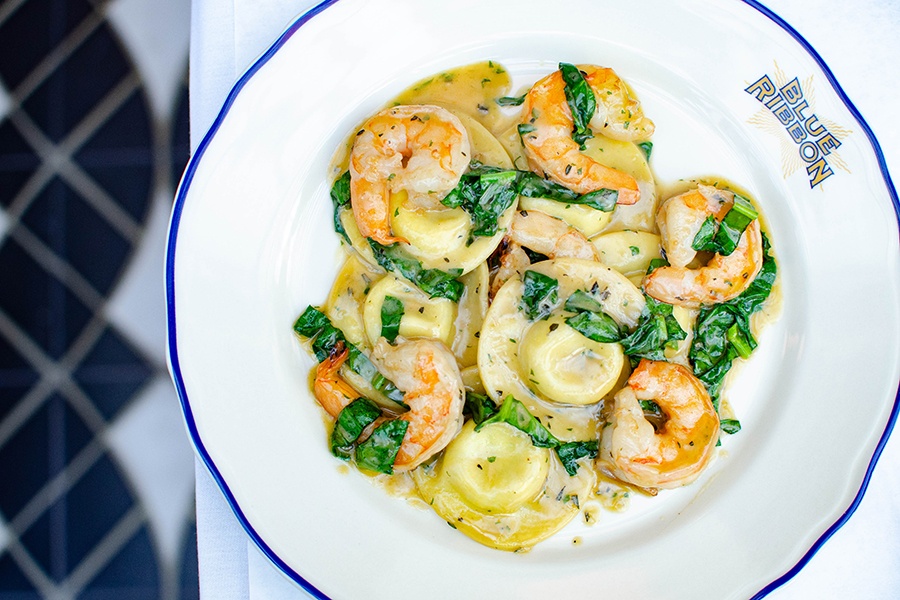
Blue Ribbon Brasserie’s shrimp Provencal: cheese ravioli and spinach. / Photo by Rachel Leah Blumenthal
Another throwback is the wor matzoh, a matzoh ball soup sized for two and jam-packed with an unholy combo of shellfish and roast pork. It’s a nod to the wor wonton at decades-old restaurant Wo Hop, still open in Manhattan’s Chinatown. (Wor, says Bruce, is a Chinese word referring to “a little bit of everything.”) “Our dad used to take us into Chinatown, and it was a real treat,” he says. “Wor matzoh is one of those dishes that really brings us back to our childhoods.”
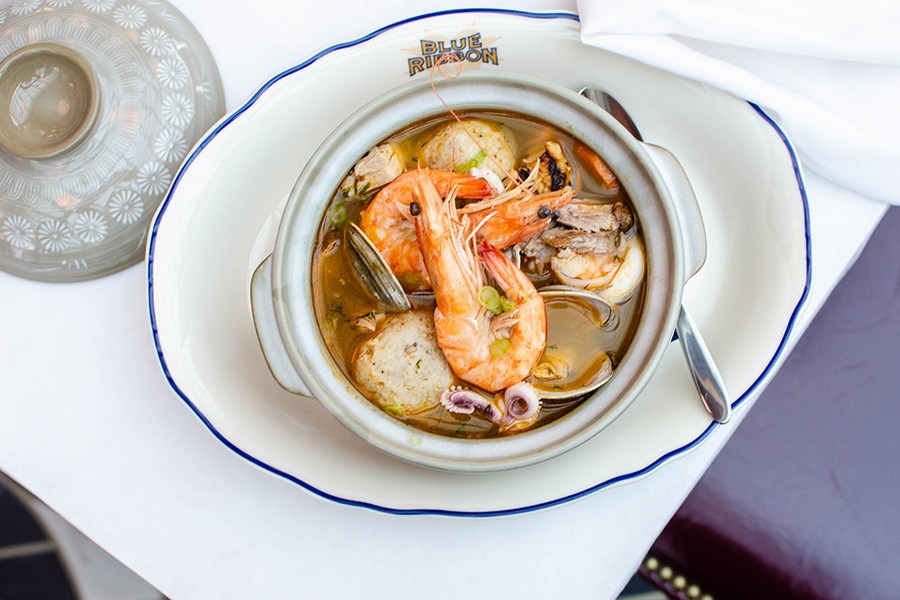
Blue Ribbon Brasserie’s wor matzoh for two: shrimp, roast pork, calamari, salmon, clams, and matzoh balls. / Photo by Rachel Leah Blumenthal
As for the rest of the menu? See it below; you’ll find escargots, steak frites, seafood platters, beef marrow and oxtail marmalade, chowder (the brothers are wisely sticking with New England-style), a giant serving of paella. It’s quite a trip.
Blue Ribbon Boston’s 260-seat space, formerly home to Boston’s own iconic brasserie Eastern Standard, is expansive. (Don’t worry, Eastern Standard lovers: It’s back, right down the street.) Blue Ribbon’s new digs are a far cry from the original Sullivan Street location, still operating today, which opened as a “very simple, extremely understated, tiny little hole in the wall,” as Bruce describes it. But it was important to the team to create some resemblance to that 48-seat restaurant, not so much in appearance as feel. “We created these nooks within the room,” says Bruce, pointing out how the positioning of the banquettes essentially creates various areas with 40 or 45 seats apiece. “They’re kind of private so you don’t feel like you’re in this big behemoth room. It was kind of an intimate feel, and that was really important to us.” Soft tones and textured wallpapers enhance the effect, he says. “We’ve always envisioned the brasserie as a place you can kind of slink into and disappear if you want to, a place where you feel super comfortable.”
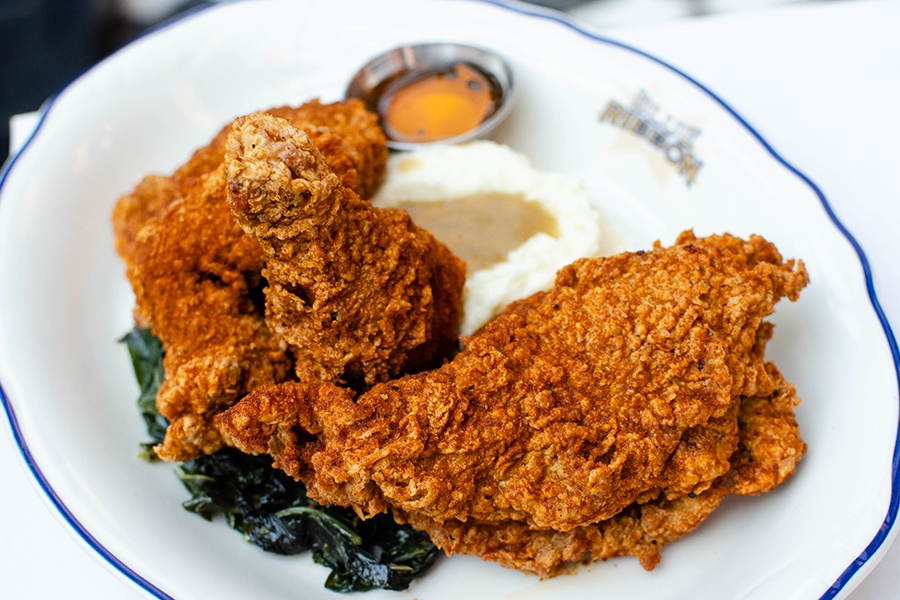
Blue Ribbon Brasserie’s fried chicken with mashed potatoes and collard greens. / Photo by Rachel Leah Blumenthal
“We’re trying to achieve a causal elegance,” adds Eric, “where there’s an elegance to the space but it’s casual in spirit and feel.” While he says every corner of the restaurant was designed with the team’s “heart and soul,” he’s particularly excited for everyone to see the raw bar, prominently featured right up front.

Blue Ribbon Brasserie’s raw bar plateau includes oysters, clams, half a Maine lobster, Jonah crab claws, and New Orleans shrimp. / Photo by Rachel Leah Blumenthal
Raw bar items have always been a mainstay for Blue Ribbon, says Bruce, noting that when the original restaurant opened, there were only a few New York City spots that were showcasing raw bars to that extent. “We were building a raw bar in the window of that tiny restaurant, and people were like, ‘Why would you do that? Nobody wants to see that!’ But from our training in France, it’s what you saw on every street. And that was part of New York, and Boston, back 120 years ago.”

The solarium at Blue Ribbon Brasserie in Boston, almost ready for opening day. (The paper will come down from the windows, letting in even more sunlight.) / Photo by Rachel Leah Blumenthal
The solarium out front—a covered but unenclosed patio in the space’s previous life—plays a large role in Blue Ribbon’s design as well, letting in plenty of light during the day. (In brasserie fashion, the restaurant will eventually be open for all-day dining.) The team has named the space the Guzy Solarium, after the project’s late architect, Peter Guzy, who collaborated on numerous restaurants with the Blue Ribbon team.
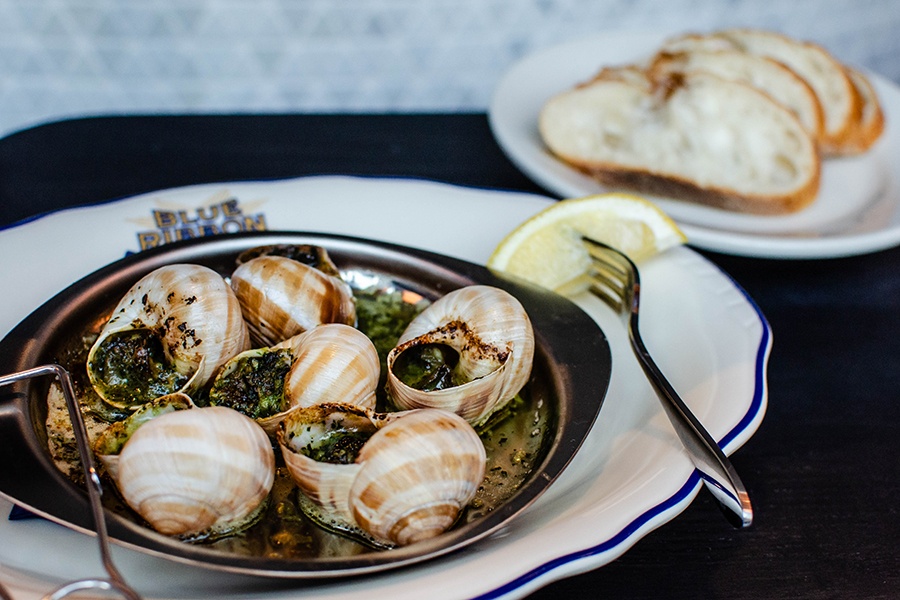
Blue Ribbon Brasserie’s escargots à la Bourguignonne with parsley, garlic, and butter. / Photo by Rachel Leah Blumenthal
“We saw this opportunity when we walked this space for the first time, a sense that we could create something really lasting and important for the city, for ourselves, and for our team for decades to come,” says Bruce. “We kind of deal in decades these days; we’re in it for the long haul.”

Blue Ribbon Brasserie’s whole steamed black flounder: scallion, cilantro, ginger, and chili. / Photo by Rachel Leah Blumenthal
“When it comes down to it, it’s not about me and Bruce; it’s about Blue Ribbon as a team—as a Boston team,” says Eric. To that end, there’s a lot of local talent on staff, including co-chefs Keith Pooler and Dan Bazzinotti, who are at the helm of the kitchen here and at the restaurant’s siblings and neighbors, Blue Ribbon Sushi and Pescador. (The duo previously worked together at Bisq, Pooler’s now-closed Cambridge restaurant.) “We’re not bringing New York to Boston,” says Eric. “We’re making a Boston restaurant in Boston that hopefully fits into the neighborhood and the vibe and the energy of the community.”
Blue Ribbon Brasserie opens December 5, 2023, with daily dinner and late-night hours to start (5 p.m. to 1 a.m.; kitchen until midnight); lunch service will begin in the new year. Reserve online. 528 Commonwealth Ave., Kenmore Square, Boston, 617-634-0404, blueribbonbrasserieboston.com.
Opening menu:
A version of this story was published in the print edition of the February 2024 issue with the headline, “Blue-Ribbon Ambitions.”
